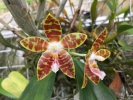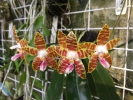|
|
|
|
|
| |
Flasks of
Phalaenopsis sumatrana 'MC7411' × sib 'MC6054' |
|
| |
|
|
| |
| Number: |
TN8469 |
| Name: |
Phalaenopsis sumatrana 'MC7411' × sib 'MC6054'
|
| Type: |
sib (What's that?) |
|
Seed Donor: |
Troy C. Meyers
|
|
Click to Enlarge

Pod Parent Flowers |
Click to Enlarge

Pollen Parent Blooming Plant |
|
|
|
| |
Comments: Pod parent plant: One of the offspring from our TN5280 effort of 2005.
Pollen parent plant: One of the offspring from our TN5280 effort of 2005.
For additional origin/habitat information supplied courtesy of
Charles and Margaret Baker, see further below, near the bottom of this page.
|
Temperatures we attempt to use in the lab & greenhouse:
| For Species: |
|
Spring, Summer, Autumn, Winter: days average 86°F, nights 73°F; best fit is Warm 90-70°F
(Source:
Baker's Web OSC) |
| For Genus: |
|
Spring, Summer, Autumn, Winter: days average 87°F, nights 64°F; best fit is Warm-Intermediate 87-64°F
(
) |
|
About the name...
| Etymology of |
Phalaenopsis |
|
From Greek, "phalaina" moth; "-opsis" appearance.
(Source:
Pridgeon 1992) |
| Etymology of |
sumatrana |
|
Means "from the island of Sumatra" (Indonesia)
(Source:
Mayr & Schmucker 1998) |
| Pronunciation of |
Phalaenopsis |
|
fail-eh-NOP-sis
(Source:
Pridgeon 1992) |
| Pronunciation of |
Phalaenopsis |
|
fal-eye-NOP-sis
(Source:
Hawkes 1978) |
| Pronunciation of |
sumatrana |
|
soo-mat-RAH-na
(Source:
Hawkes 1978) |
|
If you would like to direct someone to this web page, please copy and paste this URL into your email:
http://troymeyers.com/d?018469
| Flask Information |
| Availability: |
We have sold all of the flasks for this item. |
| You should: |
Consider getting individual plants or compots instead of a flask.
See if we have plants available in the greenhouse. |
| Yield Estimate: |
211 plants (based on flask surveys done 03/20/2018 through 06/04/2021)
|
| Plantlet Sizes: |
From many flasks 4 - 70 mm plants (based on flask surveys done 12/04/2018 through 03/10/2020)
From one most recently surveyed flask 30 - 70 mm (03/10/2020)
|
|
You might also want to:
|
View the seed assay for this item.
See if we have plants available in the greenhouse.
View items of the same species.
View items of the same genus.
|
| Ordering Information |
| You are not currently logged in. |
|
You must be a registered user and be logged in to reserve a flask or place a notification request. Please log in:
|
|
|
|
|
|
| |
The origin/habitat information below is supplied courtesy of Charles and Margaret Baker
The following information is based on the name of the plant provided by the donor, and assumes that the name is correct. If the plant has been misidentified, then the following information may not be correct.
This text is copyrighted by the Bakers and may not be reproduced without permission.
ORIGIN/HABITAT: Malaysia, Java, Borneo, Sumatra, the Philippines, Myanmar
(Burma), Thailand, and Vietnam. Plants grow on trees in shady nooks near
streams, and they thrive in the warm climate of Singapore. In Borneo,
plants have been found in Sabah, Sarawak, and Kalimantan where they grown
in hill and riverside forests from near sea level to about 2300 ft. (700
m). In the Philippines, plants have been found on Palawan Island where
they grow as epiphytes at elevations up to 2300 ft. (700 m). Plants have
been found in Peninsular Thailand near Khao Kalakiri, Pattani at 1950 ft.
(600 m). In Malaya, plants are known to occur in the states of Perak and
Johore and near Ulu Kali in Selangor.
More about this information and the Bakers...
|
|
|
| |
|
|
|